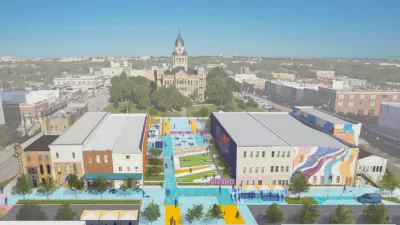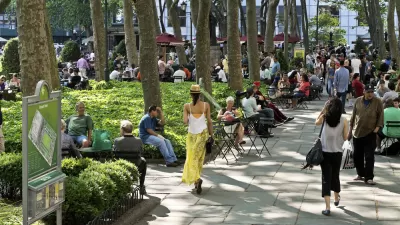Anne Schwartz compiles recent studies on the economic value of parks, describing how an investment in parks by the city will result in a healthier urban economy.
The surge in development spurred by the High Line is the latest exhibit in the growing stack of evidence that having beautiful, well-maintained parks is much more than a nice amenity cities can ignore when times are hard. In a new report Measuring the Economic Value of City Parks, researchers at the Trust for Public Land calculated dollar values for different items.
In San Diego, for example, the study determined that, with slightly less than 5 percent of tourists coming to the city especially to visit the parks, park-derived tourist spending in 2007 totaled $114 million. That generated $8.6 million in direct sales and other tax revenue as well as a collective increase of $40 million in residents' wealth.
By offering free or inexpensive recreation, parks also save residents money. In Boston, for example, the study determined that the economic value of direct park use was $354 million.
The health benefits of exercise in parks offer further savings. The study calculated $19.9 million in medical savings realized by residents in Sacramento because of active recreation in parks.
According to the report, "numerous studies have shown that the more webs of human relationships a neighborhood has, the stronger, safer and more successful it is." Well-used parks offer many ways for neighbors to get to know each other, and efforts to create, save, or care for parks create further community cohesiveness. This "social capital" can reduce a city's costs for policing, fire protection and criminal justice. Because the economic value of social capital can't be measured directly, the report cited as a proxy the amount of time and money residents contributed to "friends" groups and other park-oriented organizations and agencies.
Parks also provide quantifiable environmental benefits: Trees and vegetation absorb runoff and reduce costs for treating stormwater; they also absorb air pollutants. Using Philadelphia as an example, the study found that the city's park system saved $5.9 million in 2007 in stormwater management costs. In 2005, the 4,839 acres of tree cover in 7,999 acres of Washington, D.C. parkland produced savings of $1.13 million in air pollutant removal.
FULL STORY: Good Parks are Good for the Economy

Planetizen Federal Action Tracker
A weekly monitor of how Trump’s orders and actions are impacting planners and planning in America.

Map: Where Senate Republicans Want to Sell Your Public Lands
For public land advocates, the Senate Republicans’ proposal to sell millions of acres of public land in the West is “the biggest fight of their careers.”

Restaurant Patios Were a Pandemic Win — Why Were They so Hard to Keep?
Social distancing requirements and changes in travel patterns prompted cities to pilot new uses for street and sidewalk space. Then it got complicated.

Albuquerque Route 66 Motels Become Affordable Housing
A $4 million city fund is incentivizing developers to breathe new life into derelict midcentury motels.

DC Area County Eliminates Bus Fares
Montgomery County joins a growing trend of making transit free.

Platform Pilsner: Vancouver Transit Agency Releases... a Beer?
TransLink will receive a portion of every sale of the four-pack.
Urban Design for Planners 1: Software Tools
This six-course series explores essential urban design concepts using open source software and equips planners with the tools they need to participate fully in the urban design process.
Planning for Universal Design
Learn the tools for implementing Universal Design in planning regulations.
Heyer Gruel & Associates PA
JM Goldson LLC
Custer County Colorado
City of Camden Redevelopment Agency
City of Astoria
Transportation Research & Education Center (TREC) at Portland State University
Camden Redevelopment Agency
City of Claremont
Municipality of Princeton (NJ)





























